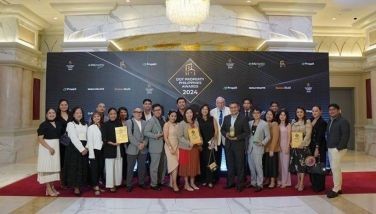LGUs must now carry burden of protecting coastal resources
July 11, 2004 | 12:00am
The burden of reversing the dire conditions of the country’s coastal and marine resources are increasingly falling on the shoulders of local government units (LGUs) as national government agencies have stepped back and gradually delegated such a critical function to local chief executives with the enactment of the Local Government Code.
The responsibilities are huge given the startling facts. Total marine landings have leveled off to just 1.6 million to 1.8 million metric tons since the early 1990s because of resource depletion and intense competition in shallow, nearshore fishing grounds. The fishing level for demersal or bottom-dwelling fish and small pelagic or surface-living fish is excessive. By the mid-1980s, the level of effort exceeded what was required to harvest maximum economic yield by 150-300 percent, and maximum sustainable yield by 30-130 percent. Current catch rates if reef fishes are among the lowest in the world; assessment of tuna indicates that the fishing pressure on the stocks in Philippine waters is relatively high and small-sized tuna comprises a large fraction of the catch.
Also, catch of large pelagic fishes such as marlin, swordfish and sailfish have gone down substantially from about 25,000 MT in the late 1980s to only 9,000 - 15,000 MT annually in the 1990s. Mangroves are less than a third of the original 450,000 hectares in 1918, seagrasses are severely degraded during the last 50 years while 70 percent of the country’s coral reefs where fish spawn, are in a poor state.
Despite the alarming numbers, the lack of funds as well as the limited technical know-how are keeping LGUs from making coastal resources management (CRM) their priority mandate.
In the soon-to-be launched book "In Turbulent Seas: The Status of Philippine marine fisheries," (published and funded by various agencies such as the Department of Agriculture, Bureau of Fisheries and Aquatic Resources, the Department of Environment and Natural Resources and the United States Agency for International Development) a compilation of articles and research papers that provides a comprehensive view of the current status of marine fisheries in the Philippines, one of the authors, Rose-Liza V. Eisma, said that LGUs have a long way to go in appreciating CRM.
In her article: "Local Governance for Municipal Fisheries: Can Local Governments Afford to Have Coastal Resource Management as a Basic Service Responsibility," Eisma noted that LGUs do not treat CRM as a priority area or a basic service that needs to be delivered to their constitutents because there is no specific mandate that requires them to do so. If and when local governments undertake CRM, funding, among others, becomes a major issue.
Eisma stressed that LGUs generally lack the creativity to adequately tap funding for CRM despite the availability of such from both government and non-government sources. Government sources include local taxes, fees, licenses, charges as well as from national sources such as internal revenue allotments. Under the Philippine Fisheries Code, LGUs can generate revenues for CRM purposes. From non-government sources, LGUs can raise funds by forging agreements with non-government organizations.
Despite available funding sources, LGUs often complain that CRM is an "underfunded mandate." In a 1997 survey of coastal mayors, 75 percent cited inadequate funding for coastal management as one key constraint. The survey also showed that while LGUs can impose taxes or fees for the use of municipal waters, many are still hampered with the lack of legitimacy and political will to collect this tax base.
As a result, the principal revenue source still comes from their share of IRA. Based on their current share in IRA, LGUs cannot meet the needed budget for CRM. Without the needed funds, LGUs are forced to reduce personnel and shelve local programs and activities. But given the national government’s growing fiscal problems, it is inevitable that LGUs rely on their creativity and resourcefulness in providing other funding sources for CRM.
CRM activities such as establishment of marine reserves, law enforcement, rehabilitation of mangroves, setting up of environment-friendly enterprises in coastal areas, and purchase of boats require a budget of at least P1 million to P13 million yearly.
Eisma also noted that most LGUs are dealing with more local problems with devolved functions and less support from national agencies such as the DENR. And with the absence of a formal institutional arrangement for a single national agency to coordinate coastal management, LGUs have to take on this added responsibility if they are to preserve and sustain their primary source of livelihood and ensure food security.
As LGUs have to rely more and more on internal fund sources, programs aimed at CRM do not get priority. Worse, priorities for implementing CRM-related activities depend on the will of local officials. Making matters even more difficult to give CRM due attention is the political in-fighting among local chief executives.
Eisma stressed that LGUs have to shape up or face the ugly consequences of having to deal with a largely depleted coastal and marine resource.
Among her recommendations are for CRM to become a basic mandate of LGUs which would provide local governments stronger basis for appropriating funds and imposing taxes, licenses and fees.
Moreover, the Program and Policy Advocacy Group (PPAG), consisting of select individuals from national government agencies, NGOs, people’s organizations, academe and other coastal stakeholders, suggested funding mechanisms to strengthen the CRM capabilities of LGUs.
These include: amending specific provisions of the Local Government Code to make CRM a basic service similar to health, agriculture and other critical sectors; include municipal waters in the computation for sharing in the IRA; develop guidelines for the Environmental Guarantee Fund to include CRM and appropriate special funds for CRM programs of LGUs in the General Appropriations Act.
The other recommendations are the review and revision of guidelines to include use of the 20 percent Development Fund for CRM; LGUs should increase their share of local sources of revenues and mandate the allocation of a portion for CRM activities; make CRM as a priority area in annual investment plans and legislate through an ordinance, a special assessment tax or fee for a local CRM fund similar to the Special Education Fund as a collected through the real property tax.
Of course, LGUs can tap private sector funds and NGOs to bankroll their CRM programs. Foreign donors are another source such as the USAID, United Nations Development Program and Global Environment Facility.
Beyond funding issues however, the LGUs should develop a mindset to carry out CRM consistently and on a sustained level that will ensure marine resources are not further decimated.
The responsibilities are huge given the startling facts. Total marine landings have leveled off to just 1.6 million to 1.8 million metric tons since the early 1990s because of resource depletion and intense competition in shallow, nearshore fishing grounds. The fishing level for demersal or bottom-dwelling fish and small pelagic or surface-living fish is excessive. By the mid-1980s, the level of effort exceeded what was required to harvest maximum economic yield by 150-300 percent, and maximum sustainable yield by 30-130 percent. Current catch rates if reef fishes are among the lowest in the world; assessment of tuna indicates that the fishing pressure on the stocks in Philippine waters is relatively high and small-sized tuna comprises a large fraction of the catch.
Also, catch of large pelagic fishes such as marlin, swordfish and sailfish have gone down substantially from about 25,000 MT in the late 1980s to only 9,000 - 15,000 MT annually in the 1990s. Mangroves are less than a third of the original 450,000 hectares in 1918, seagrasses are severely degraded during the last 50 years while 70 percent of the country’s coral reefs where fish spawn, are in a poor state.
Despite the alarming numbers, the lack of funds as well as the limited technical know-how are keeping LGUs from making coastal resources management (CRM) their priority mandate.
In the soon-to-be launched book "In Turbulent Seas: The Status of Philippine marine fisheries," (published and funded by various agencies such as the Department of Agriculture, Bureau of Fisheries and Aquatic Resources, the Department of Environment and Natural Resources and the United States Agency for International Development) a compilation of articles and research papers that provides a comprehensive view of the current status of marine fisheries in the Philippines, one of the authors, Rose-Liza V. Eisma, said that LGUs have a long way to go in appreciating CRM.
In her article: "Local Governance for Municipal Fisheries: Can Local Governments Afford to Have Coastal Resource Management as a Basic Service Responsibility," Eisma noted that LGUs do not treat CRM as a priority area or a basic service that needs to be delivered to their constitutents because there is no specific mandate that requires them to do so. If and when local governments undertake CRM, funding, among others, becomes a major issue.
Eisma stressed that LGUs generally lack the creativity to adequately tap funding for CRM despite the availability of such from both government and non-government sources. Government sources include local taxes, fees, licenses, charges as well as from national sources such as internal revenue allotments. Under the Philippine Fisheries Code, LGUs can generate revenues for CRM purposes. From non-government sources, LGUs can raise funds by forging agreements with non-government organizations.
Despite available funding sources, LGUs often complain that CRM is an "underfunded mandate." In a 1997 survey of coastal mayors, 75 percent cited inadequate funding for coastal management as one key constraint. The survey also showed that while LGUs can impose taxes or fees for the use of municipal waters, many are still hampered with the lack of legitimacy and political will to collect this tax base.
As a result, the principal revenue source still comes from their share of IRA. Based on their current share in IRA, LGUs cannot meet the needed budget for CRM. Without the needed funds, LGUs are forced to reduce personnel and shelve local programs and activities. But given the national government’s growing fiscal problems, it is inevitable that LGUs rely on their creativity and resourcefulness in providing other funding sources for CRM.
CRM activities such as establishment of marine reserves, law enforcement, rehabilitation of mangroves, setting up of environment-friendly enterprises in coastal areas, and purchase of boats require a budget of at least P1 million to P13 million yearly.
Eisma also noted that most LGUs are dealing with more local problems with devolved functions and less support from national agencies such as the DENR. And with the absence of a formal institutional arrangement for a single national agency to coordinate coastal management, LGUs have to take on this added responsibility if they are to preserve and sustain their primary source of livelihood and ensure food security.
As LGUs have to rely more and more on internal fund sources, programs aimed at CRM do not get priority. Worse, priorities for implementing CRM-related activities depend on the will of local officials. Making matters even more difficult to give CRM due attention is the political in-fighting among local chief executives.
Eisma stressed that LGUs have to shape up or face the ugly consequences of having to deal with a largely depleted coastal and marine resource.
Among her recommendations are for CRM to become a basic mandate of LGUs which would provide local governments stronger basis for appropriating funds and imposing taxes, licenses and fees.
Moreover, the Program and Policy Advocacy Group (PPAG), consisting of select individuals from national government agencies, NGOs, people’s organizations, academe and other coastal stakeholders, suggested funding mechanisms to strengthen the CRM capabilities of LGUs.
These include: amending specific provisions of the Local Government Code to make CRM a basic service similar to health, agriculture and other critical sectors; include municipal waters in the computation for sharing in the IRA; develop guidelines for the Environmental Guarantee Fund to include CRM and appropriate special funds for CRM programs of LGUs in the General Appropriations Act.
The other recommendations are the review and revision of guidelines to include use of the 20 percent Development Fund for CRM; LGUs should increase their share of local sources of revenues and mandate the allocation of a portion for CRM activities; make CRM as a priority area in annual investment plans and legislate through an ordinance, a special assessment tax or fee for a local CRM fund similar to the Special Education Fund as a collected through the real property tax.
Of course, LGUs can tap private sector funds and NGOs to bankroll their CRM programs. Foreign donors are another source such as the USAID, United Nations Development Program and Global Environment Facility.
Beyond funding issues however, the LGUs should develop a mindset to carry out CRM consistently and on a sustained level that will ensure marine resources are not further decimated.
BrandSpace Articles
<
>
- Latest
Latest
Latest
October 23, 2024 - 9:30am
By May Dedicatoria | October 23, 2024 - 9:30am
October 11, 2024 - 3:45pm
October 11, 2024 - 3:45pm
October 10, 2024 - 11:30am
October 10, 2024 - 11:30am
October 5, 2024 - 12:08pm
October 5, 2024 - 12:08pm
September 24, 2024 - 1:00pm
September 24, 2024 - 1:00pm
September 13, 2024 - 4:00pm
September 13, 2024 - 4:00pm
Recommended





























